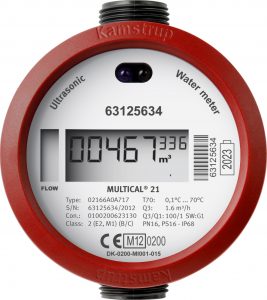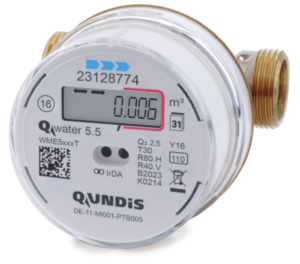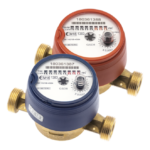+372 6799 361
Remote reading water meters
Remote reading water meters measure the volume (in m³) of consumed water flowing through the measuring instrument. They use radio waves to transmit water consumption readings and the operating status of the measuring instrument to the accounting centre and, from there, via the internet to the operator’s server. Consumers can receive monthly consumption readings from the operator or can use a server solution, in which case they can monitor the readings from their remote reading water meters in a web environment using any device of their preference – a desktop or laptop computer, or a tablet, or even a smartphone.
A remote reading water meter must be selected based on flow rates (m³/h), and the quality and temperature of the water. In terms of the way in which they are made and operate, water meters are similar to heat meters, but are much more simple. Until recently mechanical water meters were the most common means of measuring water usage in Estonia, but the new European Union requirements and new technical options that have become available have brought along increased level of interest in ultrasonic water meters.
Nowadays, particular interest is being paid to remote meter readings, both for water supply companies and final consumers. The primary advantage of remote readings is that they help to eliminate large monthly differences between readings that come from an apartment building’s general water meter and the totalled readings that have been submitted by the residents of that building. All information is recorded at the same time, making life easier and more convenient for the apartment building’s residents. In buildings that are supplied with remote reading water meters, residents no longer have to read their water meters in places that are dark and difficult to access (such as in collector cabinets, etc.). Providing remote readings also protects people from calculations being based on approximate or untimely data in order to be able to calculate the usage of ‘general water’ which the apartment building’s residents have not actually consumed.
There are also water meters available without a remote reading module, these being mechanical and ultrasonic water meters. Nevertheless, we recommend choosing a more contemporary solution in order to spare you money, time, and a degree of worry.
Mechanical water meters
The operating principle behind mechanical water meters is based on a measurement of the number of rotations that are carried out by the turbine in proportion to the amount of water that flows through the water meter. The number of rotations taken by the turbine is forwarded to a dry roller mechanism by means of a four-pole magnetic clutch. That guarantees that the system is air-tight. The specially-constructed magnetic clutch on the water meter (some models contain a magnetic screen made of a special alloy) is strongly isolated from the potential impact of external magnetic fields. This simple yet durable single-jet system helps to achieve minimum pressure drops and a great level of technical reliability. In addition, the modern and reliable construction of the measuring instrument guarantees great measuring accuracy and stability. The selection includes simple water meters with an analogue display as well as more contemporary water meters with an electronic display and various communication modules.
Ultrasonic water meters
 The operating principle behind ultrasonic water meters is based on using locators to measure the ultrasound dispersion rate in the sensor’s measuring channel, where one acts as a transmitter and the other as a receiver. The speed at which the water moves is calculated on the basis of the difference in stationary and moving water, and this is later used in calculating the flow rate and volume.
The operating principle behind ultrasonic water meters is based on using locators to measure the ultrasound dispersion rate in the sensor’s measuring channel, where one acts as a transmitter and the other as a receiver. The speed at which the water moves is calculated on the basis of the difference in stationary and moving water, and this is later used in calculating the flow rate and volume.
Ultrasonic water meters usually have an electronic display. Where they are installed does not affect the accuracy of the measuring results, and they are much less sensitive to any impurities in the water in comparison to mechanical meters. Needless to say, ultrasonic meters also have a longer life span than mechanical meters, because they do not contain any moving parts. Depending on the specific need we can supply the simplest water meters as well as water meters with various optional communication modules: an M-Bus or a wireless 838MHz radio module. It does not matter whether you are building an in-house local network for monitoring consumption levels or whether you wish us to provide you with a fully-hosted remote reading service, contact us and we will work out the best solution for you.
- Kadaka tee 181, 12618 Tallinn
- +372 6799 361
- info@optimatic.ee




